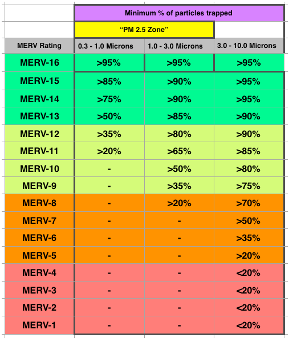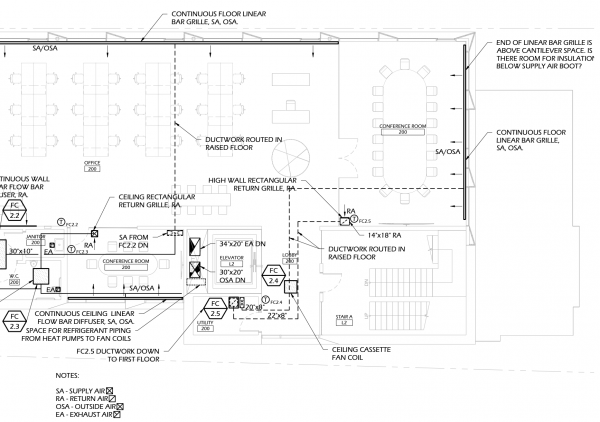Beyond Efficiency is highly motivated to solve the nation’s housing crisis and planet’s climate crisis through our technical work, but the traditional building consulting model isn’t going to cut...
Image: Beyond Efficiency schematic mechanical design for new office building with direct outside air system (DOAS)
The last virus considered a pandemic was the H1N1 flu virus in 2009. Influenza vaccines now include a 2009 H1N1-like virus with CDC.gov stating that “the (H1N1)pdm09 virus continues to circulate as a seasonal flu virus.” As our society has had to acclimatize vaccines to include H1N1, so too will it have to adjust to COVID-19, not only from a health care perspective, but also in the built environment. Beyond Efficiency has been receiving numerous requests for COVID-19 recommendations as they relate to heating, ventilation, and air conditioning (HVAC) systems. Below is an outline of available opportunities to reduce the potential for virus transmission through a building's HVAC systems.
Infectious diseases are spread through aerosols, large droplets at short range, fomites (intermediate surfaces – clothes, furniture, etc.), water/food, direct contact with an infected person, and via insects/animals. There are still many unknowns regarding the methods of spread of SARS CoV2, the virus responsible for COVID-19. The CDC recently updated their guidelines on how COVID-19 spreads to include airborne transmission via small droplets and particles. “There is evidence that under certain conditions, people with COVID-19 seem to have infected others who were more than 6 feet away. These transmissions occurred within enclosed spaces that had adequate ventilation.” How long the virus remains infectious in the air has not yet been established. The HVAC recommendations listed below only address aerosol and fomite transmission via the HVAC system.
The American Society of Heating, Refrigerating and Air-Conditioning Engineers (ASHRAE) is continually working on their recommendations as they relate to SARS CoV2. These recommendations are continually evolving as more is learned about this virus. The general recommendations below have the potential to reduce the risk of infection in all building types. For more detailed explanations, refer to the link provided under Additional Information.
Ventilation (aerosol)
- Dedicated outside air/exhaust air systems (DOAS) provide outside air (mechanical ventilation) directly to each occupied space, diluting indoor airborne infectious agents while providing local exhaust source control. It is not known what level of dilution is required to achieve a measurable reduction in COVID-19 disease transmissions. At this time, the recommendation is to ensure that the code required ventilation is distributed directly to each occupied space. There is no evidence that increasing the amount of outside air beyond code levels is necessary.
- Operable windows that can be opened to provide cross ventilation of the space during temperate outdoor air conditions will assist in dilution of indoor airborne infectious agents during occupied hours.
Airborne Transmission (aerosol)
- Zoned heating and cooling systems reduce the spreading of airborne infectious agents throughout a building that may occur with a single air handling unit with air recirculation.
- Elevator lift ventilation fans can be turned on to remove airborne infectious agents within the elevator enclosure.
- Minimum MERV 13 filtration (greater than 90% of particles 3.0-10.0 microns trapped, greater than 85% of particles 1.0-3.0 microns trapped, greater than 50% of particles 0.3-1.0 microns: see reference chart below) for all HVAC systems upstream of return and outside air to equipment to capture airborne infectious agents. Ensure that the HVAC system is sized to handle static pressure across the filter. If the HVAC system is existing, the system will need to be reviewed to ensure it can accommodate the higher static pressure from a more effective filter without reducing airflow and compromising system performance. If the existing HVAC system can’t accommodate the higher static pressure from a higher MERV filter, portable HEPA filtration units are an option.
 "
"
Filter effectiveness by MERV rating and particle size chart, provided by Think Little
Air Distribution (fomite)
- Air supplied and returned at low velocities to reduce surface disturbances, which can entrain airborne infectious agents that have settled on surfaces. When possible, return/exhaust high in the space and deliver the filtered supply and outside air to the user’s breathing zone.
UV Disinfection (aerosol)
- Portable ultra-violet germicidal irradiation (UVGI) devices or UVGI mounted in the forced air systems to remove airborne infectious agents. UVGI devices are more costly to install than other recommendations. Our recommendation is to install UVGI devices if a building houses high risk occupants.
Humidity Control (aerosol)
- Ideal indoor humidity levels are between 40 and 60% as viruses are less prevalent in this range. Humidity control systems are more costly to install and maintain than other recommendations. Our recommendation is to design a humidity control system if a building houses high risk occupants.
Additional information
ASHRAE Technical Resources





